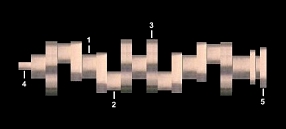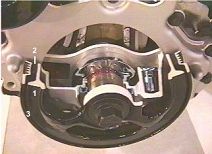The Crankshaft
Note: This content is directly from our Road Machines Educational CD, available for purchase and download instantly in our store.
Crankshaft:
 The crankshaft is designed to convert the up and down motion of the pistons into horizontal rotation. The shaft is one solid piece made from cast iron or forged steel. Steel is usually used in high loading situations, such as diesel or turbocharged engines. Oil passages are either cast or drilled into the crankshaft to distribute lubricant to the main and rod journals.
The crankshaft is designed to convert the up and down motion of the pistons into horizontal rotation. The shaft is one solid piece made from cast iron or forged steel. Steel is usually used in high loading situations, such as diesel or turbocharged engines. Oil passages are either cast or drilled into the crankshaft to distribute lubricant to the main and rod journals.
Main Journals:
The crankshaft's main journals (1) are the highly polished surfaces located at the center of the shaft. The rotation axis of the crankshaft runs through the center point of the main journals. The main journals rotate in the main bearing bore created by the engine block and main caps.
Rod Journals:
The rod journals (2) are highly polished surfaces to which the connecting rods attach. They circle around the crankshaft's axis of rotation. The amount of torque they deliver is determined by the distance between the journal's center axis and the axis of rotation. The journals are designed so there is always at least one piston on a power stroke.
Counterweights:
Counterweights (3) balance the crankshaft. The weight of the piston and connecting rod, in combination with the offset of the rod journal, will produce a violent vibration if the crankshaft were not balanced.
Snout:
The crankshaft snout (4) extends through the front end of the engine block. The camshaft timing assembly is directly connected to the snout, as are engine-driven accessories.
Flange:
The crankshaft flange (5) is the mounting structure for the engine's flywheel. The center of the flange has a pilot hole for the transmission's input shaft or torque converter.
Harmonic Balancer:
 The harmonic balancer (also called vibration damper) is designed to dampen crankshaft vibration. The down force on each rod journal can be as high as one ton. This flexes the crankshaft causing vibration. Without damping, engine damage (crankshaft failure) would result. The damper is a heavy disk mounted in rubber. The unit is attached to the crankshaft's snout. Shown are the Inertia Ring (1), Rubber Ring (2), and Crankshaft Pulley (3).
The harmonic balancer (also called vibration damper) is designed to dampen crankshaft vibration. The down force on each rod journal can be as high as one ton. This flexes the crankshaft causing vibration. Without damping, engine damage (crankshaft failure) would result. The damper is a heavy disk mounted in rubber. The unit is attached to the crankshaft's snout. Shown are the Inertia Ring (1), Rubber Ring (2), and Crankshaft Pulley (3).


